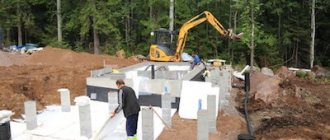Artificial drainage
If there are no such conditions, you can make artificial drainage of the area with your own hands. There are various ways to drain a site.
Before laying the foundation of dacha buildings, materials are laid that allow moisture to pass through well.
If necessary, drainage of the entire area can be arranged. Its arrangement is most important in areas with a high clay content, since they drain water very poorly.
Solving the drainage problem
Undoubtedly, carrying out drainage work with the involvement of specialists in conducting hydrogeological research, designing individual underground wiring of utility networks is an expensive pleasure and only a few can afford it.
Taking this factor into account, most summer residents who are faced with this problem try to solve it on their own, that is, to drain the site with their own hands.
Pipe placement
The drainage scheme for a site located on a slope is very simple. One ditch is dug across it, and the second - parallel to the base.
The communication of the ditches is ensured by connecting trenches. The lower ditch should provide water outlet into a stream or ditch.
How to make drainage using pipes
Knowing the technology, you don’t have to turn to professionals for help. Now let's look in detail at how to make drainage on the site:
Before starting work, create a simple drainage diagram for the area, this will make further work much easier.
Dig ditches; their depth should be from 40 to 60 centimeters.
We recommend reading:
- Recreation area in the country: beautiful ideas, application and arrangement in landscape design (125 photos and videos)
- Do-it-yourself garden gate: modern models and unusual options for using gates (110 photos)
Options for arranging the yard of a private house - the best design ideas, preparation options and tips for creating a beautiful backyard area (90 photos)
Then check the evenness of the created trench using a ruler and a building level.
The bottom of the trench is covered with a 7-centimeter layer of sand and thoroughly compacted.
Pipes are laid on a layer of sand and connected to each other. Try to use fittings that do not create a height difference. In this case, the drainage pipes will not become clogged.
A 15 cm layer of gravel is poured on top, and the final layer will be made of soil. Then the earth must be thoroughly compacted, and the work will be completed!
We recommend laying geotextiles at the very bottom, then the drainage can last a very long time. The advantage of using this material is that it does not allow soil and sand to mix. It also prevents trees and weeds from sprouting.
In this article you learned how to make site drainage with your own hands, we hope that this information will be useful to you. We wish you success!
Closed drainage ditches
It is important to make good drainage in your summer cottage. Since constantly stepping over ditches is very inconvenient, closed-type drainage systems are much more popular.
Methods for water drainage
Open way
Involves the installation of trays made of concrete or stone. Ditches are dug at marked points on the site. They have an open appearance, but for safety and mainly to protect against the ingress of third-party debris of various sizes, they can be covered with decorative grilles.
When someone needs an economical option for draining water from a site, to remove water flows from the territory, exposed ditches covering the perimeter of the territory or located at the lowest elevation of the ground surface are the best choice.
The depth of the grooves is set at a level at which significant water flows do not rise above the closing gratings. The construction of the groove walls is carried out at an angle of 30 to avoid collapses.
Closed method
Water flows enter special water-permeable drainage pipes laid in the ground. The pipe distribution is discharged through a hole arranged into the inside of the storage well, or the discharge site becomes a drainage ditch or ravine. If there is a nearby reservoir, the water flow can be discharged into the reservoir.
The closed type of water removal from the site is more optimal for sandy soils.
Method characterized as backfill type
Drainage is arranged in an area that is located on soil where loam predominates or clay soils dominate. Laying of pipework is also carried out in ditches, but in this case, the underlying layers of sand and gravel base (pillow) are first installed. This allows you to retain water coming from nearby soils.
To ensure good drainage in a summer cottage, this issue is thoroughly studied. The thickness of the bedding layer is determined by the ability of the soil to retain moisture. The worse this process goes, the more powerful the underlying cushion.
Second option
For the second organization option you need:
- Dig a trench 1.5 shovels deep with a slope towards the drain.
- Cover it with geotextile, which will act as a filter to prevent silting of the ditch.
- Fill with expanded clay or crushed stone in a layer of about 10 cm.
- Pour sand.
- Fill the soil removed from the ditch back.
- Lay turf.
Pottery drainage
Ditches with pipes laid inside them are called pottery drainage. It consists of a central pipe located diagonally across the section with pipes of smaller diameter connected on different sides. If the soil does not drain water well, pipes should be laid much more often.
For pottery drainage, you can use pipes made of plastic, cement or concrete. They can also be made from four stacked bricks. It is important to ensure that the required level of inclination is available. A water catcher is also required.
It’s possible to drain the area yourself!
Drainage is not a difficult task, so it can be done without outside help. Once you become familiar with the technology for draining water from the site, you will be able to successfully complete this job.
The instructions provided below will help you complete the task.
With drainage well
The drainage well is designed quite simply. It collects the upper groundwater, which is gradually filtered. Clean water flows into the lower layers of the soil. Several drainage wells are often made on the territory of the dacha.
To make a well use:
- Concrete perforated rings.
- A plastic ring with holes made in it.
- A piece of pipe with holes.
The bottom of the plastic ring or pipe is covered with crushed stone. After this, a cylindrical pit is installed to a depth of about 2 m.
The finished well does not need to be covered with a lid. It would be much more beautiful to fill the well with rubble or broken bricks, on top of which turf is laid. This design looks especially impressive on soil with a high clay content.
In areas with a large area, the pipe system becomes very branched. Excess moisture flows by gravity into a common collector, from which the filtration field enters.
Removing moisture
To ensure high-quality drainage of an area with a high groundwater level, it is important to drain the soil. If groundwater flows at a depth of more than 3 meters, then the area does not need to be drained.
If groundwater is located close, the soil becomes very soft under the influence of moisture. Such a section is extremely dangerous, as the foundation will begin to sag, and in such cases it may simply break.
Landscaping and drainage
When a dacha is used not only for work, but also for recreation, its owners try to make the site as attractive as possible.
When landscaping the area, you should definitely consider the drainage system. It is best to arrange closed grooves. They decorate the landscape with their appearance.To ensure water drainage from the area near the house, water inlets are made. Water from the roof will flow into them through the tray. A sand trap is placed inside the water intake, which will prevent clogging of the drainage channels. The water receiver is covered with a perforated lid.
In the rest of the territory, the trenches can be lined with stone. This design will be an excellent design element for the site.
You should not place such a trench right in front of the house. It will fit perfectly into the garden area. In addition, collecting moisture in the trenches will ensure better growth of plants growing near them.
An open drainage ditch with a bridge across it will look very nice.
Photos of the drainage system on the site show how attractive they can look if properly designed.
Where is water drainage necessary?
A flat area definitely needs drainage. If the moisture formed as a result of heavy rains and melting snow does not find an outflow route, it simply remains in place, intensively saturates the soil and leads to swampiness, the appearance of mud and global waterlogging of the earth.
A site located in a lowland disappears without a good drainage system. All the water from higher places flows onto it, and the area, at best, becomes oversaturated with moisture, and at worst, it becomes flooded.
Land located at a sharp slope loses a number of its valuable qualities without drainage. Too quickly receding water erodes the top fertile layer of soil and significantly reduces the level of productivity.
Image gallery
Photo from
Low-lying land plot
High groundwater level
Drainage improvement on a site with a slope
Laying a drainage pipe in loams
For areas with clay and loamy soils, drainage is an objective need. Rocks of this type are characterized by high density and poor conductivity. The moisture that falls in the form of atmospheric precipitation stagnates in it for a long time and leads to general waterlogging of the area, soil shifts and disruption of the fixed stability of the foundations of residential and commercial buildings.
You cannot do without a full-fledged drainage system even where the level of natural groundwater is less than 1 meter. If you ignore the drainage, there is a risk of flooding of the basement and basement rooms, the integrity of the foundation is compromised, and cracks appear on the main, load-bearing walls. All this in the future may lead to partial or complete collapse of residential and commercial buildings.
In the event of a seasonal increase in the natural groundwater level, residential buildings and outbuildings with buried foundations fall into the risk zone. In this case, its sole is at risk, and moisture and dampness may appear in basements and basements, even those equipped with good waterproofing.
To avoid these unpleasant moments, it is necessary to design a drainage system and implement it at the planning stage of building a house or immediately after purchasing the property.
An almost obligatory phenomenon, which is caused by the lack of a high-quality drainage system on the site, is cracks in the walls. Of course, they can be puttied, but the integrity of the internal space will already be compromised and the room will become vulnerable to the penetration of dampness and cold.
For areas that are partially or completely concreted, paved with paving stones, paving slabs or colored mosaics, the presence of drainage channels and gutters is a must. Otherwise, after rains or melting snow, puddles will stagnate on the surface, causing cracking of the top decorative layer and compromising the integrity of the entire coating.
It is also necessary to equip drainage where lawns are located, equipped with progressive automatic irrigation systems. This will allow you to control the level of soil moisture and prevent the death of rare plants as a result of silting of the soil.
Drainage channels make it possible to quickly remove water from a site and prevent it from flooding buildings, spoiling landscape design and harming the area’s infrastructure.
Photo of drainage on the site
Total
Category: Instructions











